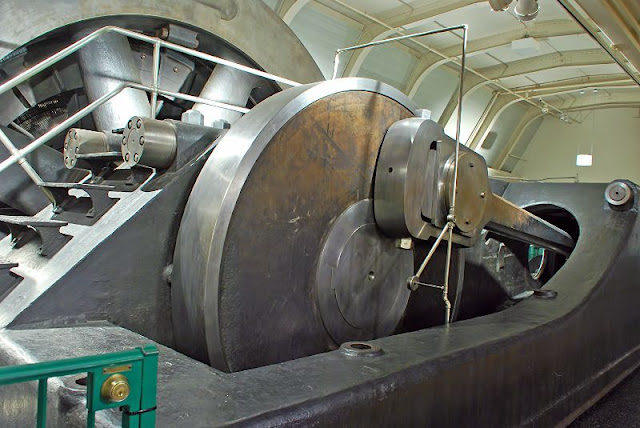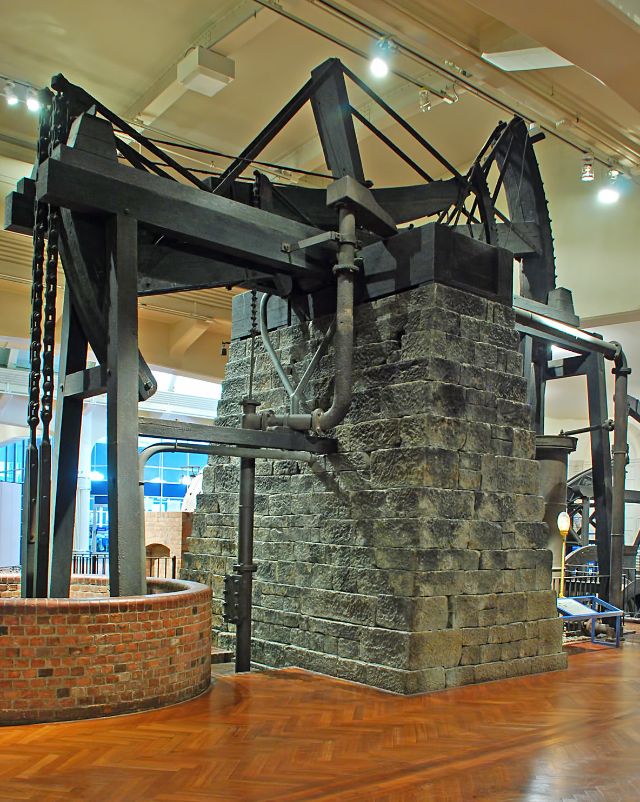The Henry Ford (also known as the Henry Ford Museum of American Innovation and Greenfield Village, and as the Edison Institute) is a history museum complex in the Detroit suburb of Dearborn, Michigan, United States.
The museum collection contains the presidential limousine of John F. Kennedy, Abraham Lincoln’s chair from Ford’s Theatre, Thomas Edison’s laboratory, the Wright Brothers’ bicycle shop, the Rosa Parks bus, and many other historical exhibits.
It is the largest indoor–outdoor museum complex in the United States and is visited by over 1.7 million people each year. It was listed on the National Register of Historic Places in 1969 as Greenfield Village and Henry Ford Museum and designated a National Historic Landmark in 1981 as “Edison Institute”.
These photos were taken by
Steve Brown that give a glimpse into historic industry inside the Henry Ford Museum.
 |
| 1816 Henry Maudslay precision lathe |
 |
| 1829 Stephenson 'Rocket' at the Henry Ford Museum. Robert Stephenson built the 'Rocket' in 1829 as the winning entry in a locomotive design contest. Though quite simple in design, the locomotive attained a speed of 29 1/2 mph |
 |
| 1891 Edison general electric 500 Kilowatt dynamo no.4 |
 |
| 1891 Edison steam engine and electric generator |
 |
| 1897 general electric generator (detail) at the Henry Ford Museum |
 |
| 1897 general electric generator at the Henry Ford Museum |
 |
| 1903 electric generator at the Henry Ford Museum |
 |
| A Chesapeake and Ohio 2-6-6-6 Allegheny, built by the Lima Locomotive Works in 1941 |
 |
| A Chesapeake and Ohio 2-6-6-6 Allegheny, built by the Lima Locomotive Works in 1941 |
 |
| A Chesapeake and Ohio 2-6-6-6 Allegheny, built by the Lima Locomotive Works in the 1940s |
 |
| A Chesapeake and Ohio 2-6-6-6 Allegheny, built by the Lima Locomotive Works in the 1940s |
 |
| A Chesapeake and Ohio 2-6-6-6 Allegheny, built by the Lima Locomotive Works in the 1940s |
 |
| A Chesapeake and Ohio 2-6-6-6 Allegheny, built by the Lima Locomotive Works in the 1940s |
 |
| A Gothic style steam engine, circa 1855 |
 |
| Bangor & Aroostook railroad coach no.6 replica. Coach was built in 1925-28 to replicate a Bangor and Aroostook Railroad coach from the 1855 to 1965 era. Bangor & Aroostook was a railway in the state of Maine |
 |
| Bangor & Aroostook railroad coach no.6 replica. Coach was built in 1925-28 to replicate a Bangor and Aroostook Railroad coach from the 1855 to 1965 era. Bangor & Aroostook was a railway in the state of Maine |
 |
| Bangor & Aroostook railroad coach no.6 replica. Coach was built in 1925-28 to replicate a Bangor and Aroostook Railroad coach from the 1855 to 1965 era. Bangor & Aroostook was a railway in the state of Maine |
 |
| Bessemer and Lake Erie no. 154 (a 2-8-0 Consolidation) was built by the Baldwin Locomotive Works in 1909 and is now displayed in the museum's railroad exhibit |
 |
| C&O 1601 Allegheny locomotive |
 |
| C&O no. 1601 Allegheny locomotive at The Henry Ford Museum |
 |
| C&O no. 1601 Allegheny locomotive at The Henry Ford Museum |
 |
| DeWitt Clinton Replica in the Henry Ford Museum. The DeWitt Clinton locomotive began operation in upstate New York on the Mohawk and Hudson River Railroad in 1831 |
 |
| DeWitt Clinton Replica in the Henry Ford Museum. The DeWitt Clinton locomotive began operation in upstate New York on the Mohawk and Hudson River Railroad in 1831 |
 |
| DeWitt Clinton Replica in the Henry Ford Museum. The DeWitt Clinton locomotive began operation in upstate New York on the Mohawk and Hudson River Railroad in 1831 |
 |
| Exploded 1923 Model T Ford at Henry Ford Museum |
 |
| Gas-steam engine, built in 1916 by the Hooven Owens Rentschler Co. of Hamilton, Ohio |
 |
| Gas-steam engine, built in 1916 by the Hooven Owens Rentschler Co. of Hamilton, Ohio |
 |
| Looking small in comparison – The C&O no. 1601 Allegheny locomotive at The Henry Ford Museum |
 |
| The Canadian Pacific snowplow in the Henry Ford Museum |
 |
| The Canadian Pacific snowplow was built in 1923. The Detroit, Toledo & Ironton Caboose was built in 1925, when Henry Ford owned the railroad |
 |
| World's oldest surviving steam engine (circa 1760). An incredible Thomas Newcomen steam engine that was used to pump water out of a deep mine in England |
 |
| World's oldest surviving steam engine (circa 1760). An incredible Thomas Newcomen steam engine that was used to pump water out of a deep mine in England |
 |
| World's oldest surviving steam engine (circa 1760). An incredible Thomas Newcomen steam engine that was used to pump water out of a deep mine in England |









































0 comments:
Post a Comment